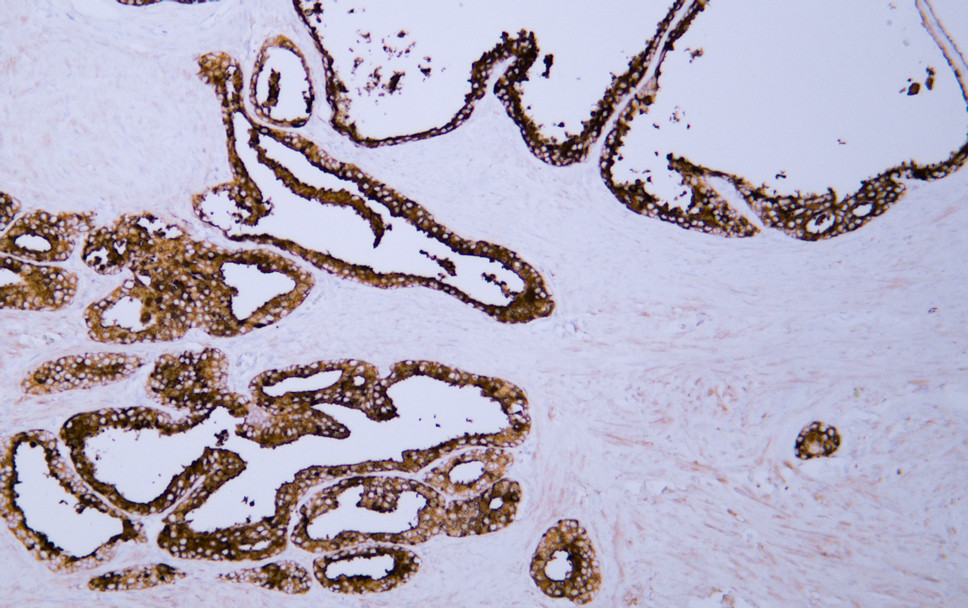Prostatic Acid Phosphatase (PAP) (ABT119) IHC kit
- Catalog No.:IHCM6906
- Applications:IHC
- Reactivity:Human;Mouse;Rat;
- Target:
- PSAP
- Gene Name:
- ACPP
- Protein Name:
- PSAP
- Human Gene Id:
- 55
- Human Swiss Prot No:
- P15309
- Immunogen:
- Synthesized peptide derived from human PSAP AA range: 201-300
- Specificity:
- The antibody can specifically recognize human PSAP protein.
- Source:
- Mouse, Monoclonal/IgG2b, kappa
- Purification:
- The antibody was affinity-purified from ascites by affinity-chromatography using specific immunogen.
- Storage Stability:
- 2°C to 8°C/1 year
- Other Name:
- Prostatic acid phosphatase (PAP;EC 3.1.3.2;5'-nucleotidase;5'-NT;EC 3.1.3.5;Ecto-5'-nucleotidase;Thiamine monophosphatase;TMPase) [Cleaved into: PAPf39]
- Background:
- This gene encodes an enzyme that catalyzes the conversion of orthophosphoric monoester to alcohol and orthophosphate. It is synthesized under androgen regulation and is secreted by the epithelial cells of the prostate gland. An alternatively spliced transcript variant encoding a longer isoform has been found for this gene. This isoform contains a transmembrane domain and is localized in the plasma membrane-endosomal-lysosomal pathway. [provided by RefSeq, Sep 2008],
- Function:
- catalytic activity:A phosphate monoester + H(2)O = an alcohol + phosphate.,similarity:Belongs to the histidine acid phosphatase family.,subcellular location:Predominantly localized in the plasma membrane but also detected in intracellular vesicles.,subunit:Homodimer.,
- Subcellular Location:
- Cytoplasmic
- Expression:
- Highly expressed in the prostate, restricted to glandular and ductal epithelial cells. Also expressed in bladder, kidney, pancreas, lung, cervix, testis and ovary. Weak expression in a subset of pancreatic islet cells, squamous epithelia, the pilosebaceous unit, colonic neuroendocrine cells and skin adnexal structures. Low expression in prostate carcinoma cells and tissues. ; [Isoform 2]: Widely expressed. Expressed in the sarcolemma of skeletal muscle.
- June 19-2018
- WESTERN IMMUNOBLOTTING PROTOCOL
- June 19-2018
- IMMUNOHISTOCHEMISTRY-PARAFFIN PROTOCOL
- June 19-2018
- IMMUNOFLUORESCENCE PROTOCOL
- September 08-2020
- FLOW-CYTOMEYRT-PROTOCOL
- May 20-2022
- Cell-Based ELISA│解您多样本WB检测之困扰
- July 13-2018
- CELL-BASED-ELISA-PROTOCOL-FOR-ACETYL-PROTEIN
- July 13-2018
- CELL-BASED-ELISA-PROTOCOL-FOR-PHOSPHO-PROTEIN
- July 13-2018
- Antibody-FAQs
- Products Images

- Human kidney tissue was stained with Anti-Prostatic Acid Phosphatase (ABT119) Antibody
.jpg)
- Human prostate tissue was stained with Anti-Prostatic Acid Phosphatase (ABT119) Antibody
.jpg)
- Human prostate tissue was stained with Anti-Prostatic Acid Phosphatase (ABT119) Antibody

- Human prostatic adenocarcinoma tissue was stained with Anti-Prostatic Acid Phosphatase (ABT119) Antibody



